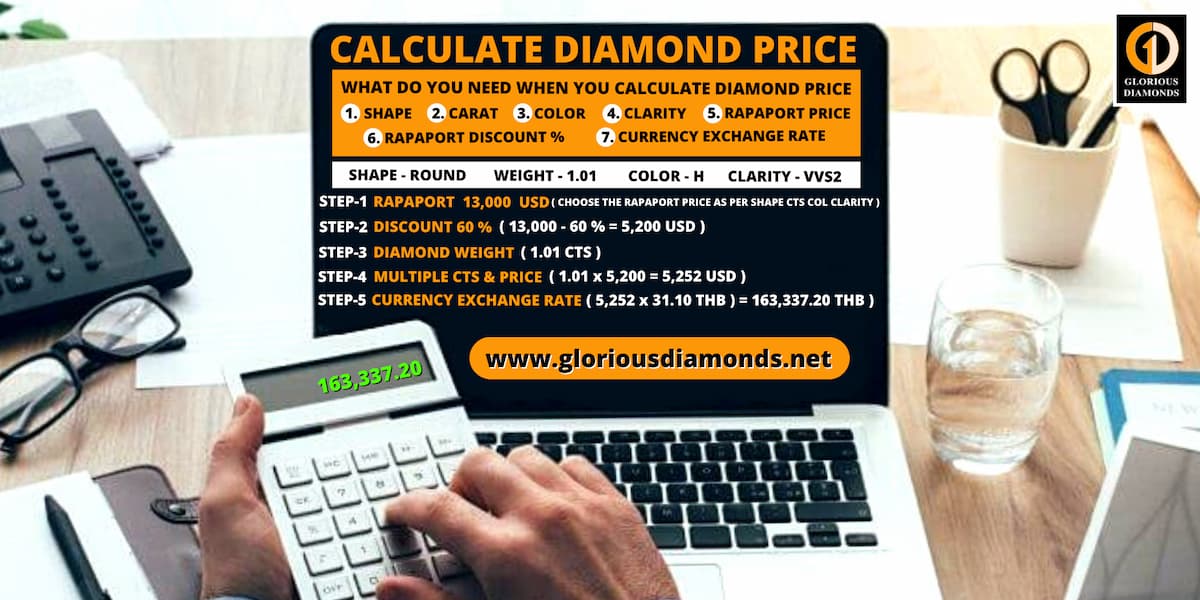Diamond prices in the diamond market are normally based on the diamond’s characteristics. The Rappaport diamond report, called as Rap list, is the global standard table price for diamond price.

Although the diamond price is standardly calculated with Rap list, however, some sellers provide a discount rate, or some diamond price could be higher than Rap list calculation, depending on the diamond characteristics and sellers.
Firstly, carats refer to the unit weight of the diamond, strongly affecting the diamond price. The higher weight of diamonds, the higher the price of diamonds.
Secondly, colours of diamonds naturally contain various shades of colours. People are normally interested in colourless diamonds, however, the more colourless a diamond looks, and the higher the diamond price they have.
Thirdly, clarity refers from flawless (FL) to imperfect (I1/ I2/ I3). Flawless diamond mainly affects the higher diamond price because it is the most attractive diamond without any scratch visible even with 10x magnification.
Lastly, cuts refer to the proportion of the diamond. The depth, width, symmetry, and facet are factors affecting the diamond price. In the cut process, maintaining the weights and beauty of diamonds makes a diamond valuable.
In order to calculate the diamond price based on the Rapaport price, the diamond’s carat is needed to be defined.
To calculate 1 carat diamond, firstly place the diamond on the sensitive weighing scale, grams unit.
Secondly, calculate diamond carat by receiving grams unit divided by 0.2 grams. For instance, diamonds weighing 0.1 grams resemble 100 milligrams, then, divide by 0.2 grams which is equal to 0.5 carat or 50 points
Clarity rating of diamond is a part of 4Cs components, affecting on 1 carat diamond price.
As a rule, clarity rates mostly impact on the diamond’s price estimation. Diamond naturally comes along with blemishes more or less, depending on the diamonds themselves. Flawless diamonds are rares and invaluable than others.
The clarity rates are categorised into 5 rates from best to worst, including Internally Flawless (IF), Very Very Small Inclusion 1-2 (VVS1, VVS2), Very Small Inclusion 1-2 (VS1, VS2), Small Inclusion 1-2 (SI1, SI2), and Inclusion 1-3 (I1, I2, I3).
According to the ideal proportions, a 1 carat diamond approximately sized into these size chart:
The diamond ring’s size depends on the diamond's cut and a person’s finger size. Since 1 carat diamond is cut differently with diverse depth and shapes, affecting the differentiation of 1 carat diamond size.
Considering based on reality there are no static values of 1 carat diamond ring size. The average scale size of 1 carat diamond shape above refers to the average numbers. Therefore, there could be bigger or smaller 1 carat diamond within alike shapes.
In conclusion, buying a 1 carat diamond ring should be knowledge-based as it is important to make a decision. Overall, you can calculate the 1 carat diamond correctly and understand the importance of the diamond’s clarity.
Our products / services
Diamond Education
Diamond Price
GIA Certificate & Diamond Characteristics
Contact Us
919/503-504, 43rd floor,
Jewelry Trade Center Building,
Silom Road, Kwaeng Silom, Khet Bangrak
Bangkok 10500 Thailand
Customer Service +669 421 99999
+669 469 09000
Office +6626302728
Email sales@gloriousdiamonds.net






